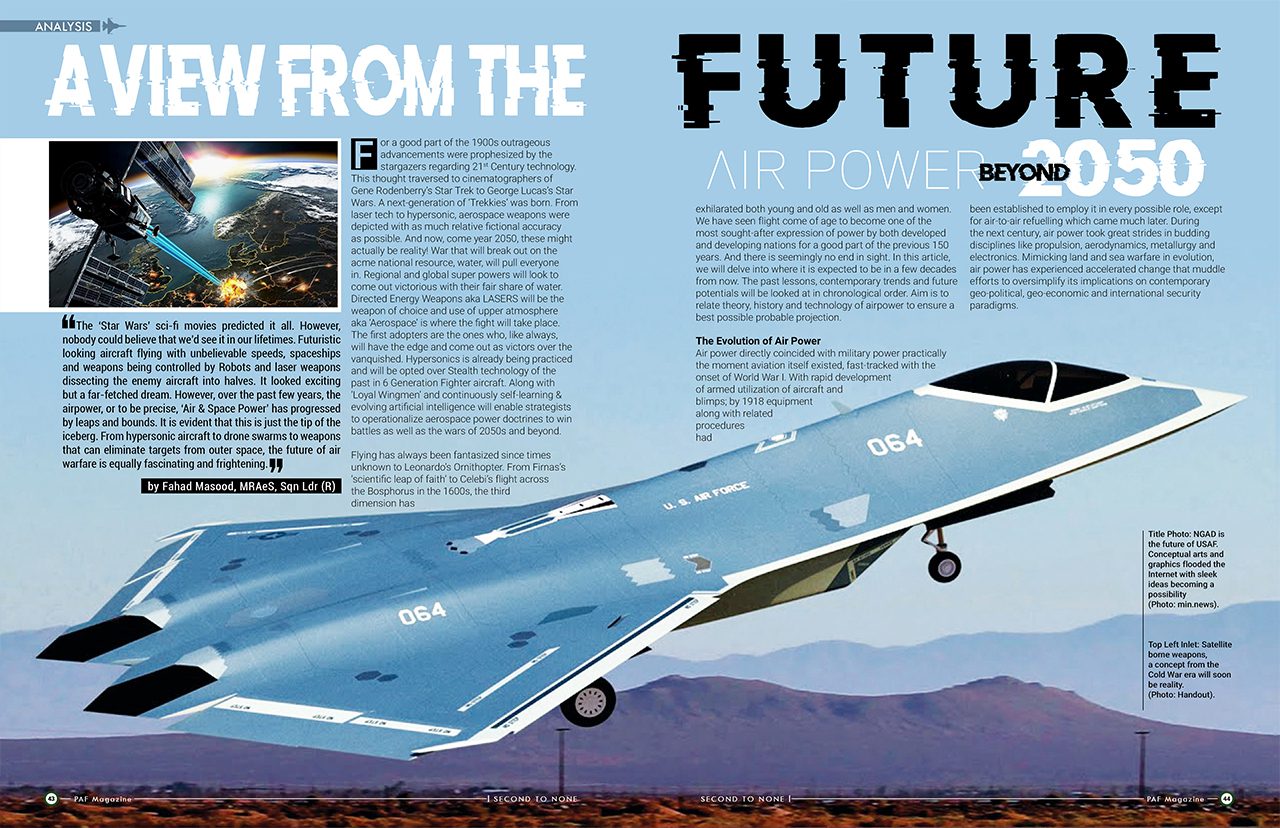The ‘Star Wars’ sci-fi movies predicted it all. However, nobody could believe that we’d see it in our lifetimes. Futuristic looking aircraft flying with unbelievable speeds, spaceships and weapons being controlled by Robots and laser weapons dissecting the enemy aircraft into halves. It looked exciting but a far-fetched dream. However, over the past few years, the airpower, or to be precise, ‘Air & Space Power’ has progressed by leaps and bounds. It is evident that this is just the tip of the iceberg. From hypersonic aircraft to drone swarms to weapons that can eliminate targets from outer space, the future of air warfare is equally fascinating and frightening.
For a good part of the 1900s outrageous advancements were prophesized by the stargazers regarding 21st Century technology. This thought traversed to cinematographers of Gene Rodenberry’s Star Trek to George Lucas’s Star Wars. A next-generation of ‘Trekkies’ was born. From laser tech to hypersonic, aerospace weapons were depicted with as much relative fictional accuracy as possible. And now, come year 2050, these might actually be reality! War that will break out on the acme national resource, water, will pull everyone in. Regional and global super powers will look to come out victorious with their fair share of water. Directed Energy Weapons aka LASERS will be the weapon of choice and use of upper atmosphere aka ‘Aerospace’ is where the fight will take place. The first adopters are the ones who, like always, will have the edge and come out as victors over the vanquished. Hypersonics is already being practiced and will be opted over Stealth technology of the past in 6 Generation Fighter aircraft. Along with ‘Loyal Wingmen’ and continuously self-learning & evolving artificial intelligence will enable strategists to operationalize aerospace power doctrines to win battles as well as the wars of 2050s and beyond.
Flying has always been fantasized since times unknown to Leonardo’s Ornithopter. From Firnas’s ‘scientific leap of faith’ to Celebi’s flight across the Bosphorus in the 1600s, the third dimension has exhilarated both young and old as well as men and women. We have seen flight come of age to become one of the most sought-after expression of power by both developed and developing nations for a good part of the previous 150 years. And there is seemingly no end in sight. In this article, we will delve into where it is expected to be in a few decades from now. The past lessons, contemporary trends and future potentials will be looked at in chronological order. Aim is to relate theory, history and technology of airpower to ensure a best possible probable projection.
The Evolution of Air Power
Air power directly coincided with military power practically the moment aviation itself existed, fast-tracked with the onset of World War I. With rapid development of armed utilization of aircraft and blimps; by 1918 equipment along with related procedures had been established to employ it in every possible role, except for air-to-air refuelling which came much later. During the next century, air power took great strides in budding disciplines like propulsion, aerodynamics, metallurgy and electronics. Mimicking land and sea warfare in evolution, air power has experienced accelerated change that muddle efforts to oversimplify its implications on contemporary geo-political, geo-economic and international security paradigms.
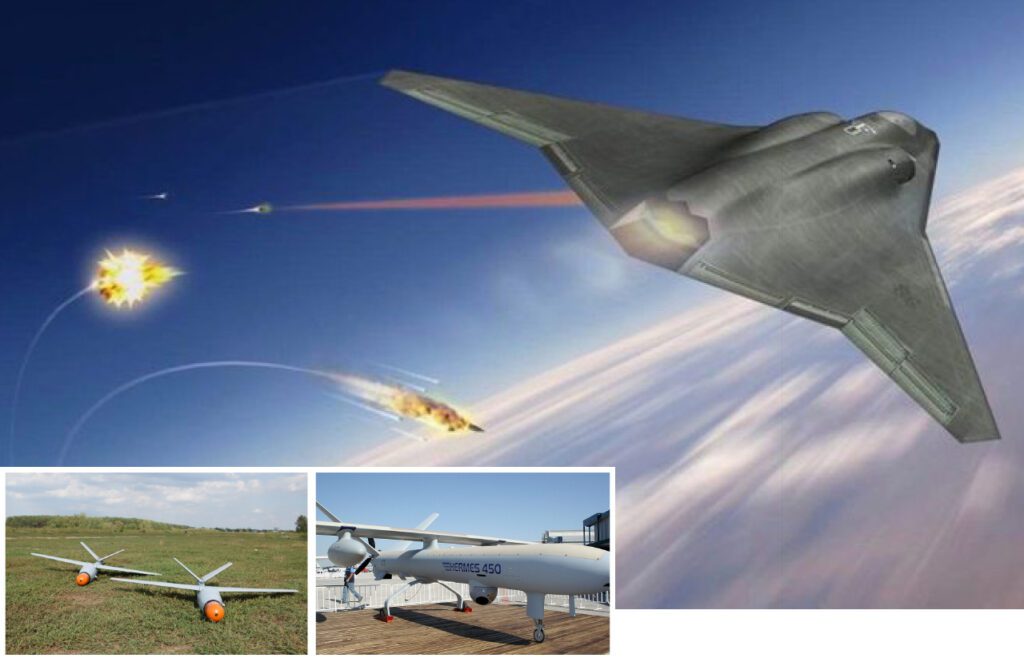
Air power doctrinal philosophy has evolved correspondingly, with names like Clausewitz, Jomini, Mahan, Corbett, Douhet, Mitchell, Trenchard, Seversky, and Slessor casting remnant shadows over air power dynamics till date. Air power was still in its puberty between WWI and WWII when these stalwart proponents of the third dimension were committed in comprehending its efficacy. Royal Air Force (RAF) came into existence in 1918 which paved the way for independent air forces, beyond control of land forces. All proponents of Air Power single-mindedly focused on relative independence of the force. Starting from long-range strategic bombing & maritime defence, ‘Command of the Air’ was considered to be the pivot. Bombers were the weapon of choice till the Fighters came up to par with the advantage of speed on their side. The expression ‘In thrust we trust!’ was born in the crucible of World War I, but came of age in the inferno of World War II. Britain became first of many countries to be subjected to strategic bombardment by cruise & ballistic missiles, namely the German V-1 and V-2. Close air support as well as Aerial interdiction played a central role in Allied counter-offensives as a follow-up to German blitzkrieg. Aircraft carriers ousted the battleship as primary combatant at sea. Furthermore, aircraft became significant apparatuses in anti-submarine manoeuvres. War was above all a contest to seize and control bases for land-based air power. All in all, just like today, penalties of degraded air superiority in relation to the enemy were potentially catastrophic.
‘Bombers will always get through’ was an idea that was pushed for long but fighter escorts were the real saviours of their iron-clad slow-speed big brothers. The uprise of masses against their own governments, demanding capitulation in order to stop the carnage, was an ill-conceived notion which failed miserably in the attacked nation states. A decisive end of war with Germany and Japan was not attained with bombing only. It required combined effects of blockades, losses on battlefield, and Axis economic mismanagement.
The ‘Absolute Weapon’ was the race post WW-II. Nuclear technology R&D was accelerated. Fighter-bombers as well as attack aircraft with solo & dual crew progressively side-lined the heavies in strike role. Forever dismantling the bomber-era of yesteryears with heavy bombers and tactical air power compromising of light bombers and fighters. PGMs (Precision Guided Munitions) have blazed the trail with LGBs (Laser Guided Bombs) over past 40 years. Air battle management along with sensor fusion became core of the air operations in Iraq, Serbia, and Afghanistan. Dynamic targeting, successful engagement of a target on the move, has been the selling point of PGMs. They have also proved their efficacy in urban area targeting, such as Baghdad, as well as against fixed military installations. Minimizing collateral is the competitive advantage it maintains against older bombs. Synergy between air and ground forces in this domain has resulted in many a success stories till date, even in cases involving relatively small ground forces.
USA had maintained an edge over the rest of the world in air power. But the tides of time are changing rather quickly with regional players like China & Russia flexing muscles in the Middle East and Africa. Globalization is ensuring democratization of technology, money and information to be available to all in this village space. ‘Carpet Bombing’ theory of the past is being replaced by accurate ballistic and cruise missiles. Unmanned aerial vehicles are gradually taking central role in all air campaigns. That’s why the future of air power looks to be heavily relying on ‘Unmanned’, however, the only question is ‘When’.
Air Power Theory
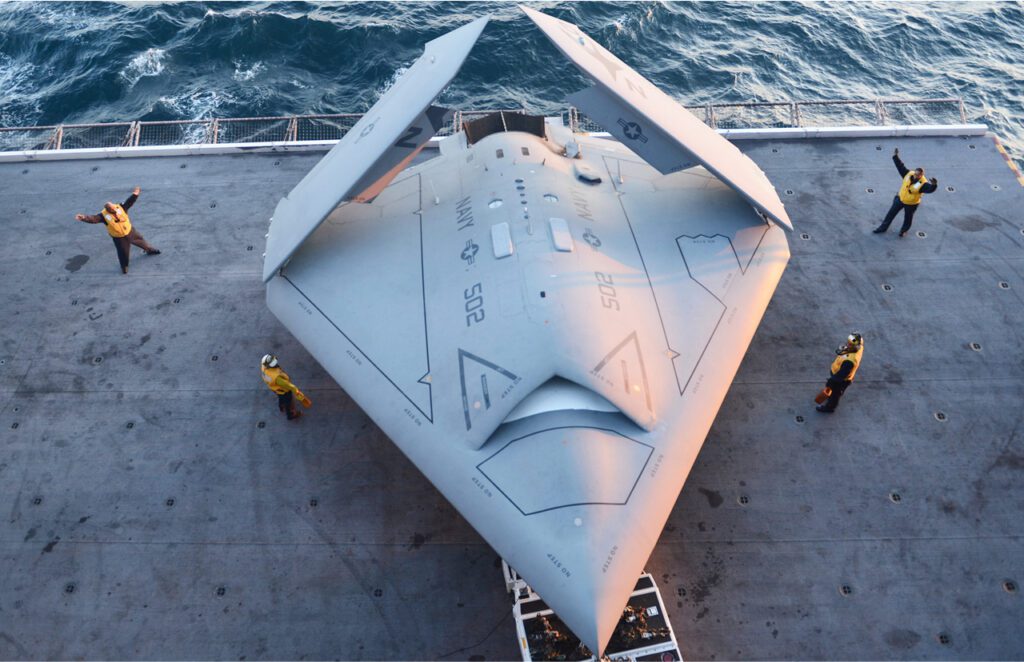
Theorists of the early decades of the previous century have put in continued efforts to delineate the land and air power characteristics. Alongside speed, reach is one the most favoured traits of air power. To overfly the engaged armies and navies to engage ‘centre of gravity’ to make decisive alteration in the thought process of the adversary commander. Second is ‘Zero Terrain Friction’ wherein the air element, unlike the army and navy, can enforce presence at greater distances and areas. Various countries define ‘Air Dominance’ or ‘Air Superiority’ as a pre-requisite to freedom of air power employment. SEAD (Suppression of Enemy Air Defence) or Counter air operations to take out adversary air element threatening the ‘pockets’ of air superiority are intermittently continual options exercised.
One of the biggest proponents and users of air power is the USAF which in true letter and spirit have put into effect ‘Global Reach! Global Power!’ with the use of long-range bombers and airlift capability generating air bridges and using coercive techniques of precision bombing. Arrival of PGMs and cruise missiles have enabled accuracy, calibrated response competency as well as minimized collateral damage via a centralized operation capability.
Various Elements at Play
As future is constantly connected to present-day, which in turn learns from history for a clear comprehension of coming events. Understanding challenges of developing security environment will be imperative to the mode in which air forces will function in times to come. And out of all variables, one is ‘Globalization’ – a double-edged sword defined as democratization of information, finance and technology, which will force the future planners to look disproportionately at world events. Correlating the intensity, technology and complexity from Fig 1, we can clearly see that the ‘complexity’ has a direct exponential relationship in air warfare.
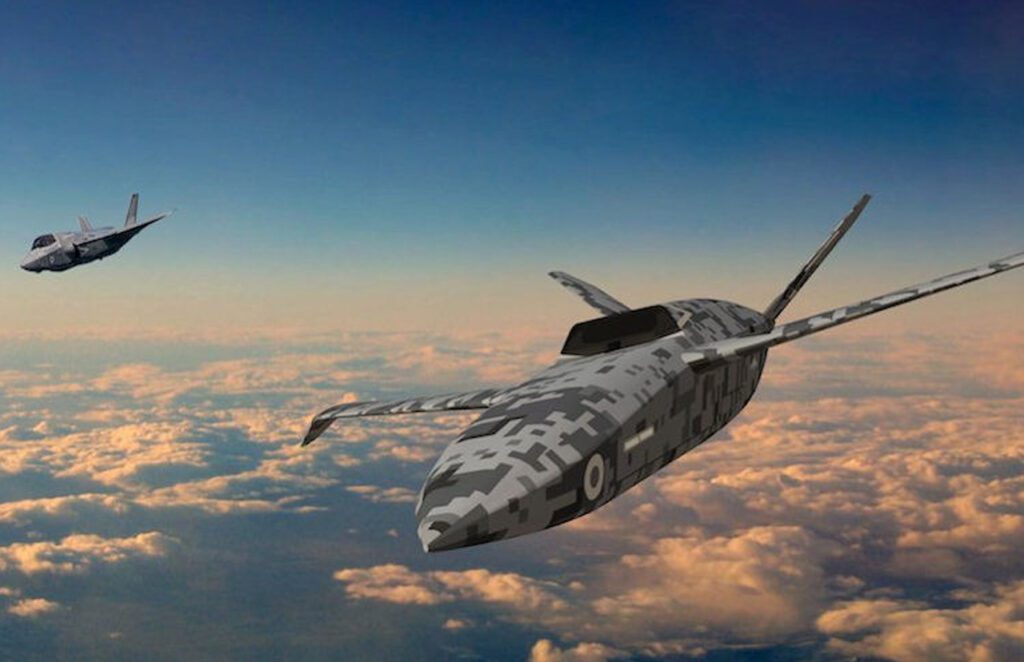
The term ‘Revolution in Military Affairs (RMA)’ was coined back in early 90’s after the Gulf War but remains pertinent in contemporary times. According to Table 1, inspired by ‘Forecasting Change in Military Technology, 2020-2040’ by Foreign Policy program at Brookings, we can point out the game-changers for the post-2050 era. In terms of speed, range, lethality, or other defining characteristics, technologies showing moderate advances might improve performance by a few percent or at most a couple of tens of percent. Those experiencing high advances will be able to accomplish tasks on battlefield far better than before—perhaps by 50 to 100 percent, to the extent improved performance can be so quantified. Finally, technology areas in which revolutionary advances occur will be able to accomplish important battlefield tasks that they cannot now even attempt.
Deducing from enumerated Table 1, broad-based technologies in air power marked in red will revolutionize the future scenarios. Delving into specific weapons will follow but with this calibrated information, it is safe to say that it is information and systems management that will play the biggest role in ensuring victory. Resources like Robotics, AI, Big Data, IOT, Cyber Ops etc will without doubt be the tip of the sword in more ways than one.
Weapons of the Future
Naming futuristic weapons of choice in the air domain following the trends in aforementioned table are problematic in many ways. But still, here it goes.
1. Autonomous Aerial Weapons
AI-based airborne robotic vehicles to search & destroy enemy troops as well as equipment on ground or in the air, without risk to friendlies (theoretically at least). Onboard computers interpret sensor data to ID and target hostile forces with built-in weapons. Robots still query human controllers at remote sites for ‘clear to shoot’, and friendly forces carry IFF transponders that identify them as ‘friends’. Difficulty remains in quick and reliable discrimination between hostile forces and neutral or friendly parties or objects, such as civilians, cows, trees, and tractors. Systems that check-in with human controllers are vulnerable to communication failures. Malfunctioning robots could fire wildly at anything and that would be a big challenge.
Prime examples of such air borne weapons are MQ-25 Stingray Unmanned Carrier Aviation Air System (UCAAS), Elbit Systems’ Hermes 450, UCAV WZ-2000 etc. Not to mention the impervious Swarm Drones namely Perdix drones, X-61A Gremlin air launched drones, US Navy and Marine Corps’ Low-Cost UAV Swarming Technology (LOCUST) program, RAF’s Lightweight Affordable Novel Combat Aircraft (LANCA) unmanned loyal wingman program, CH-901 UAVs, AVIC 601-S ‘Anjian’ etc.
2. Directed-Energy Weapons
A ranged weapon that damages targets with highly focused energy, including laser, microwaves, and particle beams fall under the umbrella of Directed-Energy Weapons. Potential applications of this technology includes weapons that target personnel, missiles, vehicles, and optical devices. In various countries like Russia, China, Turkey, Iran and United Kingdom, research has enabled them to generate directed-energy weapons and railguns to counter ballistic missiles, hypersonic cruise missiles, and hypersonic glide vehicles. The first known use of directed-energy weapons in combat took place in Libya in August 2019 by Turkey, which claimed to have used the ALKA ‘Directed-Energy Weapon’.
3. Space-Based Weapons
This is Star Wars 2.0, if not better! Space would be the ultimate battle ground. Weapons in orbit would have the ability to see and zap anything on ground, in air, or nearby in space. Main mission of space-based weapons would be to defend against ballistic missiles fired at targets on Earth. Fleets of interceptors or battle stations stationed in orbit, poised to fire at any attacking missiles. Leading approach for the future would be the use of solid projectiles – such as tungsten rods – that would impact missiles. But laser battle stations are more efficient and sustainable. Presently, technology is maturing with arrival of nanotechnology and Moore’s Law is in action. Interceptors hit warheads to destroy them, which is challenging but possible. Weapons in need of chemical fuel or electrical power would be replenished in space through a strong network of supply chain management.
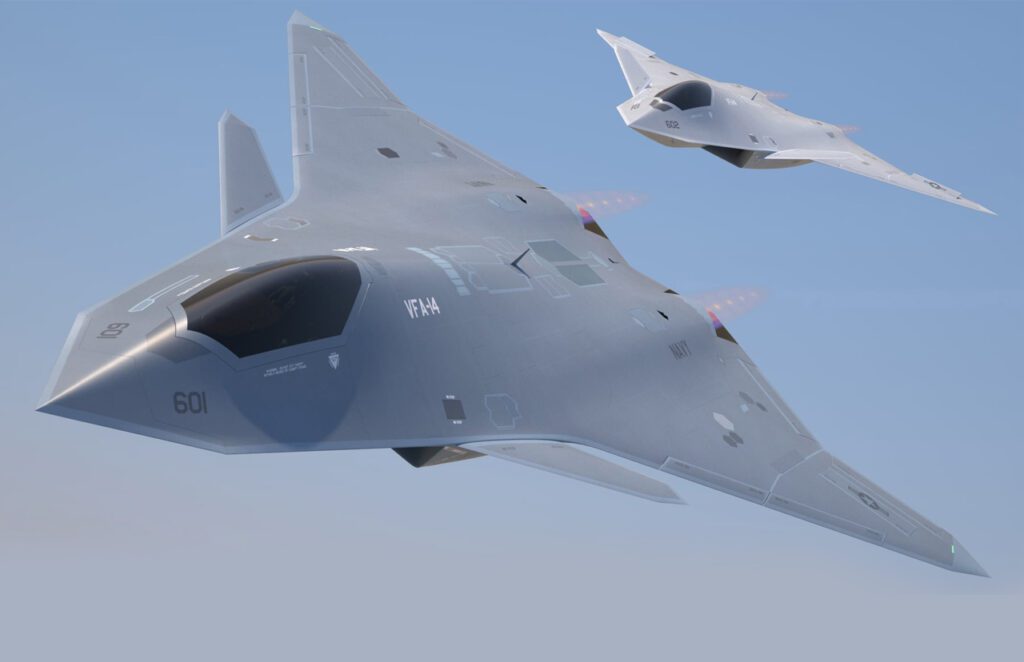
4. Hypersonic Aircraft
Launched from a standard runway, a hypersonic aircraft flies faster than Mach 5 to strike anywhere in the world in a couple of hours. It also has enough thrust to deliver a satellite to low-Earth orbit. To get off the ground from a runway, a hypersonic plane hitches a ride on a conventional plane or have its own conventional jet engine. That engine carries the hypersonic craft to an altitude where air density and resistance are less. Here it reaches supersonic speeds and then shift to its scramjet engine. The scramjet scoops up air and mixes it with fuel so it burns as the mixture flows through the engine at supersonic speeds. This means scramjets can achieve some of the speed of a rocket without having to carry heavy oxidizer (to mix with fuel), as rockets did in previous generation of thrusters. The technology matured over the previous half a century, with engineering upgrades in metallurgy and design. Scramjet engines start only when the plane flies faster than the Mach 1. Remotely piloted, UAV or UCAV are aircraft of choice for this tech because pilots are now redundant in the cockpit!
5. E-bombs
In the world of 2050 plus, everything has gone ‘e’. Something like the ‘Graphite bomb’, was used in ‘Gulf War-1’ where Saddam’s power grid was dismantled. High-power microwave pulses knock out computers, electronics, and electrical power, crippling military and civilian systems. A rapid increase in electromagnetic field strength during a pulse, induces surges of electric current in conductors. This burns out electrical equipment – semiconductor chips are particularly vulnerable. Special bombs generate the most intense pulses covering large areas, but unmanned aircraft carrying smaller generators pinpoint targets. The effects also depend on local conditions, and are hard to predict. Sensitive enemy military equipment sometimes shielded, and microwaves also disable friendly electronics within range.
6. 6th Generation Fighter Aircraft
Providing superiority in air combat domain was the push behind the 6th Generation fighter program. With the emergence and increasing use of digital and innovative technologies, countries looked for next-level fighter jet capabilities. Lets have brief look at what the air forces around the world are vying for in the future.
USA’s F/X or Next Generation Air Dominance (NGAD)
The US Air Force (USAF) was one of the leaders in the race for the development of a six-generation fighter aircraft. USAF Research Laboratory released a rendering of the next-generation aircraft F/X in March 2018, which indicated the aircraft had a sleek, stealthy design with a high-energy laser capable of cutting enemy aircraft into half. Also known as Next-Generation Air Dominance (NGAD) or Penetrating Counter Air, the future aircraft has a longer range and larger payloads, as well as the ability to carry hypersonic weapons. F/X fighters provide significant enhanced stealth capabilities and work in coordination with unmanned vehicles. The jet was developed and flown in one year. It remains unclear who designed and developed the prototype, but it is understood that advanced manufacturing technology was used to develop it.
Future Combat Air System (FCAS)
Joint programme between Germany, France and Spain, the Future Combat Air System (FCAS) delivered a next-generation fighter (NGF), which operates as part of a manned-unmanned teaming formation with attack and surveillance drones, known as ‘remote carriers’. All the flying elements are connected by a ‘Combat Cloud’ powered by AI. Air forces operate the FCAS sixth-generation aircraft at a safe stand-off distance while deploying the remote carriers in dangerous areas to deal with threats. Key capabilities of the aircraft include improved survivability with active and passive stealth features, enhanced SA through advanced avionics and sensor suite. Fighter jet also provides greater manoeuvrability, speed, and range, thanks to powerful engine and advanced flight control system. The jet is installed with novel effectors to ensure increased firepower, including stand-off kinetic loads, directed energy weapons, and electronic warfare capabilities. Dassault Aviation and Airbus were awarded a joint concept study (JCS) contract by the French and German governments for the FCAS programme in February 2019.
Russia’s MiG-41
Russia’s sixth-generation aircraft MiG-41, also known as PAK-DP, is a future interceptor that operates at extremely high altitudes at speeds exceeding Mach 4. The MiG-41, a long-range interceptor would replace the ageing MiG-31 interceptor. Developed by Mikoyan (MiG), the fighter, equipped with an interceptor missile system, provides capability to intercept hypersonic missiles. The aircraft is modified to create an unmanned variant. The new interceptor is equipped with long-range air-to-air missiles, advanced target search and detection equipment, and stealth technology.
UK’s Tempest
Launched by Britain in 2018, the Tempest fighter jet project is a trilateral cooperation between the UK, Italy, and Sweden. Combat aircraft would enter service with Royal Air Force (RAF) in 2035 as a replacement of the Typhoon. It has an adaptable architecture suitable for a range of operations, with provision to change software and hardware according to mission needs. Other key features include an advanced flight control system, enhanced survivability, and scalable autonomy. Equipped with advanced technologies such as futuristic wearable cockpits using gaming technology, eye-tracking technology, and augmented reality, the jet will serve the RAF for the next half a century. Other technologies incorporated include stealth, optional manning, directed-energy weapons and hypersonic weapons. The aircraft’s ability to exchange data with multiple platforms provides armed forces with comprehensive picture of future battlespace. It uses swarming technologies to control drones while Cooperative Engagement Capability will allow platforms to coordinate during attack or defence operations. A radar technology, known as a multi-function radiofrequency system, developed for Tempest is able to provide over 10,000 times more data than existing systems.
China’s J-X
China developed a new fighter jet with sixth-generation capabilities such as commanding drones, stealth capability, and AI. The J-X also features hypersonic weapons, laser, and swarm warfare capabilities and provides improved capabilities compared with country’s J-20 and J-31 aircraft. A 6,620 ft wind tunnel, built to support the new fighter aircraft program became operational in May 2020 by performing a flow field test for secretive new aircraft.
Space – the Final Frontier!
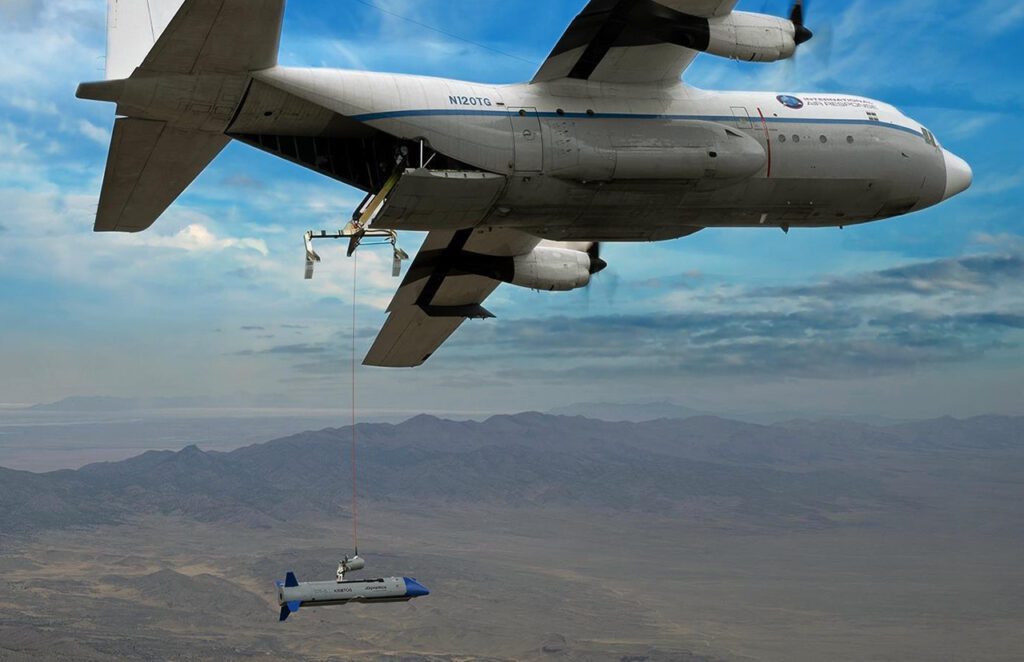
Since the days of Star Trek and Star Wars, space has been romanticized to be a place of peace. But as technology continues to evolve, things appear to go other way around. With the advent of near-space travel and space-tourism, militaries around the world are eyeing for their share of the pie. Air power is turning into Aerospace power! Majority of the countries have already renamed or are in the process of renaming their ‘air force’ as ‘aerospace force’. For instance, Iran’s IRGC Air Force converted into the IRGC Aerospace Force in 2009. Russian Aerospace Forces or VKS comprise the aerospace branch of Armed Forces of Russian Federation. Russia established the VKS as a new branch of its military on 1 August 2015 with merging of the Russian Air Force (VVS) and Russian Aerospace Defence Forces (VVKO) on recommendation of Ministry of Defence. French Air and Space Force (AAE) became air and space force of French Armed Forces on 10 September 2020. United States Space Force (USSF) is space service branch of the U.S. Armed Forces, one of the eight U.S. uniformed services, and the world’s first and currently only independent space force. So where does Space start from above mean sea level? This question needs deep deliberation. The recent ‘space’ flights by billionaires Jeff Bezos ‘Blue Origin’ and Richard Branson’s ‘Unity-22’ are up for discussion. Fédération Aéronautique Internationale (FAI) agrees with Blue Origin to define beginning of space as Kármán line at an altitude of about 62 miles. It’s also where the National Oceanic and Atmospheric Administration says “a conventional plane would need to reach orbital velocity or risk falling back to Earth.” But then you have agencies like NASA and the U.S. Air Force that defines the edge of space begins 12 miles south of the Kármán line. According to the space agency, an altitude of 50 miles is where the Earth’s atmosphere “blends into space.” But one thing is for sure, no matter which ‘Kármán line’ is followed, space is truly up for grabs and the one who exploits it as first adopter will reap the benefits for a very long time to come.
How do the ‘aerospace’ doctrines resolve real physical differences between air and space? Well, there are really two different perspectives as to doctrinal view of physical environment of space (and they are not mutually exclusive).
First, space may be viewed as a medium—like land, sea, and air—within which military activities can be conducted to achieve objectives. This view is particularly relevant at tactical (i.e., operation of specific platforms) and strategic (i.e., space as a domain that must be protected and controlled) levels of war. Former is level at which individual executing space squadrons operate while latter, consistent with national policy, is level at which unified commands focus on, as tasked by National Command Authorities (NCA).
Second doctrinal view of space is “effects-centric” and is primarily relevant at operational level of war. In theater applications, space capabilities can and do provide same ‘high-ground’ effects as air capabilities, albeit with different platforms and methods. This arena is where aerospace doctrine is primarily focused.
Most functions performed today in atmosphere by air-breathing systems may also be done in future in space. As technologies evolve, and as it becomes possible to do functions more efficiently, more effectively, and at less cost from space, then those functions will migrate to space. Doing so will provide enhanced capability, survivability and greater efficiency through multi-layering of systems. Today those migrated functions include weather, navigation, ISR and communications. In future, Air Force missions such as close air support, interdiction, offensive counterair, defensive counterair, and strategic attack may all come from space.
One of the few variations that will ‘forcefully’ creep in is the term ‘‘air superiority’ replaced by ‘space superiority’. Why? Because here we are talking of superiority in a particular physical environment. That is not to say that ‘aerospace superiority’ is not a legitimate term—it is. But it may still be theoretically possible to enjoy ‘air superiority’ without a corresponding ‘space superiority’ (and vice-versa). These two things are specific functions of platforms dependent on specific physical environment of air and/or space. Undoubtedly, however, as technology improves, distinction between ‘air superiority’ and ‘space superiority’ will become less and less apparent.
Conclusion
Is it strength in numbers or enhanced quality or diversified portfolio that will tilt the balance of air war in a proponent’s favour in 2050 and beyond? Considering the ‘theory-history-technology’ matrix, it appears that the deciding factor would be ‘a diversified portfolio’. Aerospace wars of the future with their high-tech weapons will be won by the countries that have the ability to adapt with change and make best-possible decisions in evolving and fluid situations. Humans will remain a big part of the equation because AI will still not be strong enough to take ‘creative’ and ‘moral’ decisions essential to wars. Centre of gravity of military power would be the space. Everything from navigation to communication to intelligence satellites would operate in space. If any power has to knock out the other, it would have to knock out those assets up there, first. It seems like science fiction, but one wonders how somebody in 1800s would have felt about a description of what World War II was going to be like. The details may not be as mentioned — there may be other players, it may not happen in 2050 — but historically every century had a major war. 21st century probably won’t be the first without a major global war.
